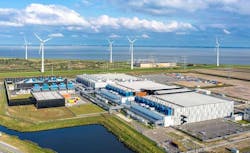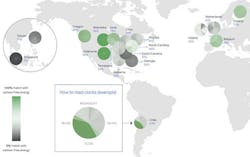Google is moving workloads between data centers to boost its use of renewable energy, shifting the data processing for YouTube videos and Google photos to locations where green power is plentiful. It’s a development that creates powerful new opportunities to green create cloud applications powered by solar, wind and geothermal energy.
Today’s news builds on Google’s carbon-aware computing strategy, and demonstrates how software and network connectivity can transcend traditional limitations on green computing. This is a growing priority for hyperscale cloud builders and their users, as climate-driven disasters bring new urgency to sustainability.
Last year Google began shifting the timing of workloads within data centers to match their energy use to the availability of renewable sources. That laid the foundation for the next step – moving the actual compute capacity to more favorable locations.
“Google can now shift moveable compute tasks between different data centers, based on regional hourly carbon-free energy availability,” said Ross Koningstein, co-founder, Carbon-Intelligent Computing at Google. “This includes both variable sources of energy such as solar and wind, as well as “always-on” carbon-free energy such as our recently announced geothermal project. This moves us closer to our goal of operating on carbon-free energy everywhere, at all times, by 2030.”
Moving data and applications between data centers in real time requires sophisticated software and LOTS of network capacity. As the world’s largest computing platform, Google has the resources to be a trailblazer in this effort, which aligns with its corporate commitments to reduce its climate impact.
As part of that commitment, Google will soon begin using geothermal energy to power its data centers in Nevada with carbon-free energy, teaming with energy startup Fervo to use fiber optic sensors to tap the earth’s own heat to power Google Cloud servers.
Addressing the Location Challenge
The recent growth of cloud computing has sharpened the focus on how data centers can retool the economy for a sustainable future. As the COVID-19 pandemic shifts more essential activities online, the carbon impact of the world’s IT infrastructure becomes even more critical in addressing climate change.
Google’s announcement brings the realization of a futuristic vision for workloads to “follow the sun” to create solar-powered IT applications. Google has added wind and geothermal power, creating a broader “follow the green” strategy that integrates a wider array of renewable sources.
Workload mobility addresses a number of challenges in matching green power to IT operations. Renewable electricity is linked to geography and weather, and most widely available in regions with sunny or windy conditions. There’s also the intermittent nature of renewable energy – solar power is only available during daylight hours. Wind energy can be used at night, but not when the wind dies down.
“The amount of computing going on at any given data center varies across the world, increasing or decreasing throughout the day,” said Koningstein. “Our carbon-intelligent platform uses day-ahead predictions of how heavily a given grid will be relying on carbon-intensive energy in order to shift computing across the globe, favoring regions where there’s more carbon-free electricity. The new platform does all this while still getting everything that needs to get done, done — meaning you can keep on streaming YouTube videos, uploading Photos, finding directions or whatever else.”
The first workloads using this location shifting include media processing tasks, in which Google encodes, analyzes and processes millions of multimedia files like videos uploaded to YouTube, Photos and Drive.
“Like many computing jobs at Google, these can technically run in many places (of course, limitations like privacy laws apply,” said Koningstein. “Now, Google’s global carbon-intelligent computing platform will increasingly reserve and use hourly compute capacity on the most clean grids available worldwide for these compute jobs — meaning it moves as much energy consumption as possible to times and places where energy is cleaner, minimizing carbon-intensive energy consumption.”
Significantly, Google Cloud’s developers and customers can also prioritize cleaner grids, boosting their use of carbon-free energy by assigning apps to regions with better carbon-free energy (CFE) scores.
Where might workloads shift within Google’s global network? The regions with the highest current CFE ratings include Oregon (89%), Sao Paulo, Brazil (87%), Council Bluffs, Iowa (78%) and Hamina, Finland (77%). At the low end of the scale are Singapore (3%) and Sydney, Australia (11%).
A Google “heat map” displaying the carbon-free energy scores for its Google Cloud regions. Click the map to see a larger version of the image. (Image: Google)
Google provides CFE data for all of its GCP regions to help companies incorporate carbon free energy into their location strategies, which may also include criteria on latency and data sovereignty.
How Google’s Carbon-Aware Computing Works
Google says its carbon-aware platform is now in use at every Google data center. The system compares forecasts for the average hourly carbon intensity of a local electrical grid, and how it will change over the course of a day. Google has also developed an internal tool to predict the hourly power resources that a data center needs to carry out its compute tasks during the same period.
The company then uses the datasets to optimize its operations on an hour-by-hour basis, aligning compute tasks with times of low-carbon electricity supply. Adding the CFE scores allows Google to optimize workloads for both time and location.
Google said it will share its methodology and performance results with the industry in upcoming research publications. “We hope that our findings inspire other organizations to deploy their own versions of a carbon-intelligent platform, and together, we can continue to encourage the growth of carbon-free electricity worldwide,” the company said.
Sustainability has been a huge priority for Google, which has been a leader in green innovation in the industry. Google optimizes every aspect of data center operations, from the chips powering servers to the power infrastructure and cooling systems. Google’s relentless focus on efficiency yielded huge savings in electricity, slashing the amount of carbon needed to operate its Internet business. Google’s data center team has focused on procuring renewable energy to power its operations instead of electricity sources based on coal. Google’s use of power purchase agreements (PPAs) for renewable energy has been adopted by other cloud providers and data center REITs.
Google has matched its electricity consumption with renewable energy purchases in each of the past three years, purchasing 1.1 gigawatts in 2019. Most of that green energy goes to support Google’s massive network of data centers, which power everything from YouTube videos to Gmail to every query you type into the search field.
Today’s announcement brings Google closer to its goal of using renewable energy to power every hour of operation of its data centers, around the clock and around the globe.
Google isn’t alone in this effort. Last year Microsoft announced plans to be carbon negative by 2030, and begin tracking the climate impact of its vendors, while Amazon and Apple have procured substantial amounts of renewable energy to support their data centers. Multi-tenant data center developers like Switch, Digital Realty, Aligned and Iron Mountain have also lined up green energy for their data center clients.







